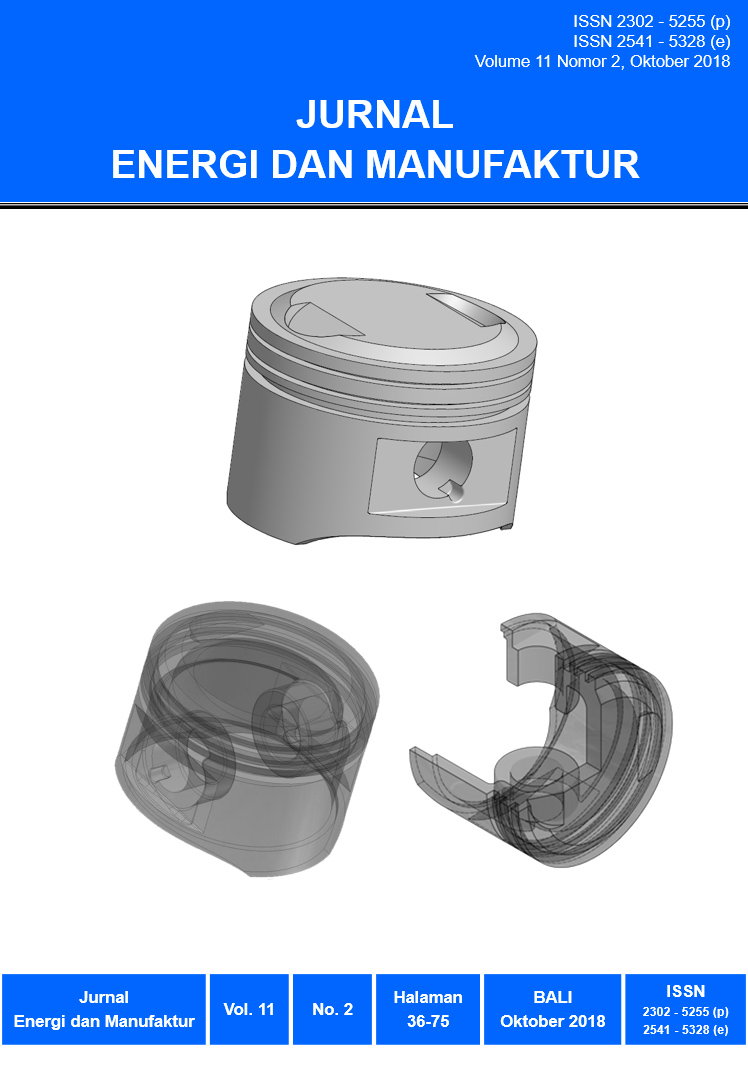Pengaruh Silinder Downstream terhadap Karakteristik Aliran Silinder Upstream Menggunakan Square Disturbance Body Tersusun Tandem
Abstract
Fluida yang mengalir di sekitar bluff body silinder sirkular, akan menimbulkan gaya-gaya aerodinamika salah satunya gaya drag. Drag sangat tidak diinginkan untuk keselamatan struktur body. Reduksi gaya drag dilakukan dengan mengontrol medan aliran seperti meningkatkan kekasaran permukaan, mengiris silinder dengan sudut iris tertentu, dan menempatkan pengganggu di sisi upstream silinder. Penelitian ini bertujuan untuk melihat pengaruh silinder downstream terhadap karakteristik aliran silinder upstream menggunakan square disturbance body yang disusun tandem pada saluran sempit. Geometri yang digunakan adalah dua silinder sirkular yang disusun tandem berdiameter (D) 25 mm dengan variasi jarak antar silinder (L/D) 1,5; 2; 2,5; 3; 3,5; 4. Square Cylinder sebagai body pengganggu ditempatkan pada sisi upstream silinder utama berdiamensi 4 mm. Posisi sudut pengganggu (?) 30°, dan jarak gap (d=0.4mm). Reynolds number berdasarkan diameter silinder, yaitu ReD 2,32x104. Penelitian iini dilakukan secara numerik 2D Unsteady-RANS menggunakan CFD software FLUENT 6.3.26 dengan model viscous Turbulence Model Shear-Stress-Transport (SST) k-?. Parameter yang diamati adalah koefisien pressure (Cp), Koefisien drag pressure (Cdp) dan visualisasi aliran berupa velocity pathline. Hasilnya menunjukkan bahwa Penambahan silinder downstream memberikan kontribusi dalam pengurangan gaya drag pada silinder upstream menggunakan square disturbance body. Pengaruh wake silinder upstream terhadap silinder downstream berkurang dengan meningkatnya rasio L/D. Interaksi wake silinder upstream terhadap silinder downstream terjadi pada konfigurasi L/D 1,5 – 3. Pengurangan gaya drag optimum terjadi pada konfigurasi L/D 3.
The fluid flows around the circular cylinder bluff body will produce aerodynamic forces, one of which is the drag force. Drag is very undesirable for the safety of the body structure. Reduction of drag force is carried out by controlling the flow field such as increasing the surface roughness, slicing the cylinder with a certain iris angle, and placing the disturbance on the upstream side of the cylinder. This purpose of the study is to see the effect of downstream cylinders on the flow characteristics of upstream cylinders using a square disturbance body arranged tandem in a narrow channel. The geometry used is two circular cylinders arranged in tandem diameter (D) 25 mm with a variation of distance between cylinders (L / D) 1.5; 2; 2.5; 3; 3.5; 4. Square Cylinder as a disturbing body is placed on the side of the main cylinder upstream with a diameter of 4 mm. The position of the disturbing angle (?) is 30 °, and the gap distance (d = 0.4mm). Reynolds number is based on cylinder diameter, ie ReD 2.32x104. This research was carried out numerical 2D Unsteady-RANS using a FLUENT 6.3.26 CFD software with viscous Turbulence model Shear-Stress-Transport (SST) k-? model. Parameters observed were pressure coefficient (Cp), drag pressure coefficient (Cdp) and flow visualization in the form of velocity pathline. The results show that the addition of a downstream cylinder contributes to the reduction of the drag force on the upstream cylinder using a square disturbance body. The wake influence of upstream cylinder to downstream cylinder decreasing with increasing the ratio of L/D. The interaction of wake cylinder upstream to downstream cylinder occurs at L/D 1.5 - 3. The optimum for the drag force reduction occurs at L/D 3.
Downloads
References
[2] Putra, R.P, Reduksi gaya hambat pada silinder sirkular dan reduksi pressure drop pada saluran sempit berpenampang bujur sangkar dengan menggunakan batang pengganggu berbentuk square cylinder. Tesis, Institut Teknologi Sepuluh Nopember, Surabaya, 2013.
[3] Rina., Widodo, W. A, Simulasi Numerik Aliran di Sekitar Circular Cylinder dengan Dua Square Cylinder sebagai Disturbance Body pada Saluran Sempit. Thermofluid VI. 29 April 2014, Yogyakarta, Indonesia. Hal. 111-116, 2014
[4] Alam, M.D., Sakamoto. H., Moriya, M, Reduction of fluid forces acting on a single circular cylinder and two circular cylinders by using tripping rods. Jurnal of fluids and structures Vol. 18, 347-366, 2003.
[5] Daloglu, A, Pressure drop in a channel with cylinders in tandem arrangement. International Communication in Heat and Mass Transfer 35, 76-83, 2008
[6] Daman, A. A. A., Widodo, W. A, Pengaruh Penambahan Inlet Disturbance Body Terhadap Karakteristik Aliran Melintasi Silinder Sirkular Tersusun Tandem. Thermofluid VI. 29 April 2014, Yogyakarta, Indonesia. Hal. 79-84, 2014.

This work is licensed under a Creative Commons Attribution-NonCommercial-ShareAlike 4.0 International License.









